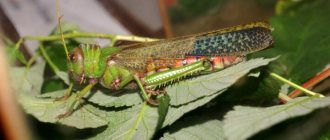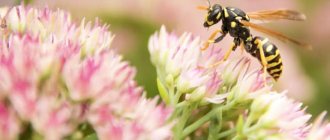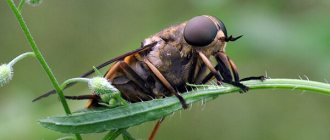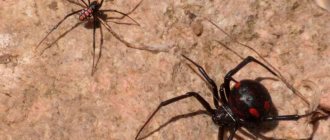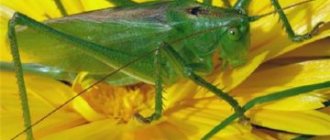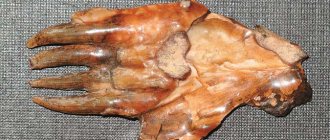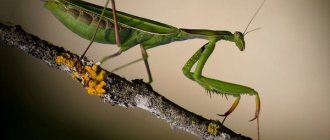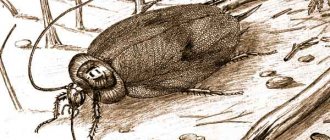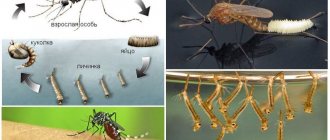Nutrition
As already noted, the grasshopper is a predator, which means its diet includes various small animals. But, besides this, grasshoppers feast on some flowers and even fruits with no less pleasure.
Locusts have no dietary preference. Apart from the fact that she is a herbivore, there are probably no restrictions. These insects generally have a high food specialization, and are among the most adaptable insects in the world.
song grasshopper
Locust
Grasshopper and locust: differences in nutrition
Grasshoppers eat smaller insects, meaning they are omnivorous predators. They are helped in hunting by the structure of their front legs and the camouflage color of their body.
The locust, unlike the grasshopper, feeds exclusively on plants. When locusts are in a swarm, they are able to travel long distances at high speeds. So, in 1954, a swarm of these insects flew from north-west Africa to Great Britain. Three decades later, in 1988, a swarm of locusts flew from West Africa and made its way to the Caribbean. These insects traveled 5,000 km in just 10 days.
Locusts eat the equivalent of their own weight per day, so when a swarm forms, they are capable of destroying huge amounts of vegetation in their path. This could have catastrophic consequences for agriculture.
Limbs
The hind legs of the grasshopper are slightly longer than those of the locust. With their help, this insect moves and pushes off when attacking prey. The forelimbs help to grab branches when moving through trees, and in addition, they are involved in catching the “future dinner”.
The front legs of a locust are much weaker than those of a grasshopper. They do not play a special role in the life of this insect; their main task is to create support when moving. And the locust's hind legs are not as long as those of its fellow, but it is thanks to them that the locust can jump so far.
Description of the insect
The locust's body is elongated, from 5 to 20 cm long , with bent hind legs, which are much longer than the front legs. The insect has hard elytra that cover the barely visible transparent wings. The wings are sometimes covered with various patterns. Locusts have small antennae that are smaller than those of a cricket or grasshopper.
Her head is big and her eyes too. The locust makes a characteristic sound, reminiscent of chirping, it is produced in a similar way: males have special notches that are located on the thighs, and they also have thickenings on the elytra. When these parts rub, a sound of different tones appears. It flies very quickly: a flock of insects can fly about 120 kilometers in a day.
The color of an insect does not depend on congenital factors ; it is influenced by the environment. Individuals from the same offspring, but living in different conditions, may have different colors. In addition, the color depends on the locust's lifestyle. For example, if a female or male leads a solitary existence, then its color may be green, gray, yellow or brown. Also during this period they have pronounced gender differences. When an insect switches to a gregarious lifestyle, it becomes the same as everyone else, and sexual dimorphism disappears. Photo of locusts:
Conclusions TheDifference.ru
- Grasshoppers belong to the Long-whiskered subfamily, grasshopper family, and locusts belong to the Short-whiskered subfamily, Filly family.
- Locusts are herbivorous insects, while grasshoppers are predators.
- Locusts harm humans, but grasshoppers are beneficial.
- Grasshoppers are most active at night, flying towards the light of a fire. Locusts prefer daylight hours for their movements and chirping.
- The locust has shorter antennae and legs than the grasshopper, but a more elongated abdomen.
- Grasshoppers lay eggs using a special ovipositor and in secluded places. Locusts lay their eggs directly in the soil.
Moroccan and Asian migratory
The body size of the Moroccan locust does not exceed 3 cm. Mature individuals are reddish-brown in color, with small dark spots scattered throughout the body. The hind legs are yellowish or pink in the thigh area and red elsewhere. Despite its miniature size, this species causes considerable damage to agricultural fields, destroying crops.
The Moroccan locust gathers in huge hordes and terrorizes the fields of Africa, Central Asia, the arid regions of Libya and Egypt, as well as some European countries: France, Portugal, Spain and Italy. In rare cases it is found on the Balkan Peninsula.
The migratory locust differs from the Moroccan locust in size: its body length varies from 3.5 to 6 cm. The color varies: bright green, brown, yellow-green, grayish. The wings have almost no color other than a slight smoky tint. The hind legs are dark brown or gray-black in the upper part. At the bottom they are beige, yellowish or pink.
This insect lives throughout Europe, Asia Minor and Central Asia, northern Africa, China and Korea. It can also be found in the southern regions of Russia, Kazakhstan and the Caucasus.
How to fight - effective methods
In areas where there is a high probability of these pests appearing in large numbers, deep plowing of the soil is usually carried out to destroy the eggs laid by the locusts in the ground.
In the spring, repeated digging and harrowing should be carried out in order to destroy clutches of eggs that the locusts could lay after autumn plowing.
During the summer season, swarms of locusts can only be effectively controlled using chemical agents.
In areas where a large number of larvae of this insect are found, pesticides are used, the validity of which is at least a month from the moment of spraying. To poison the soil and destroy pests, Karate, Confidor and similar preparations are usually used. Also suitable for combating locusts are chemicals designed to kill the Colorado potato beetle.
A systemic chemical such as Clotiamet VDG, when sprayed, protects plants from locust attacks for 19-22 days. The main positive quality of this product is the possibility of using it together with mineral fertilizers, growth stimulants or other drugs that protect plantings from pests.
The insecticide "Damilin", which is also successfully used to combat locust larvae, slows down the development of insects at this stage, and also prevents the formation of the chitinous cover of the larvae, which leads to the death of the pests. This drug is the least toxic.
Egyptian and Bluewing
The female Egyptian filly is one of the largest species of locust and grows up to 70 mm, the males are somewhat more modest - 30-50 mm. The insect has a gray, light brown and greenish color. The tibiae of the hind legs are blue, the thighs are orange, with dark spots. Locusts' eyes have black and white stripes. The Egyptian filly is found in the Middle East, northern Africa and Europe.
The blue-winged filly is a standard-sized insect with the Latin name Oedipoda caerulescens. The body length of the female reaches 28 mm, the male - 21 mm. A distinctive feature of the species is its very beautiful wings: they are blue below, colorless closer to the top.
The surface of the beautiful wings has a pattern that consists of dark-colored ray stripes. The tibiae are bluish, covered with small spines. This locust is found in the forest-steppes of Europe, the Caucasus region, Central Asia, Siberia and the territory of the People's Republic of China.
What are locusts?
Locusts are grasshoppers that develop sociable characteristics in suitable environmental conditions, forming an organized group. Such conditions are especially due to a period of dense vegetative growth following a dry period. Drought causes locusts to crowd into small areas where there is vegetation. The locusts then leave their solitary phase as grasshoppers and reproduce at incredibly high rates, forming stripes of nymphs and swarms as adults. The transition from the solitary phase is caused by the secretion of the hormone serotonin, which has been linked to increased mood in humans. In their swarms, locusts move in one direction, stopping in any green area they notice. This movement causes significant damage to crops. Locusts are known to travel long distances in short periods of time, leaving a trail of damage behind them.
Locust swarm.
Reproduction and development stages
Locusts have three stages of development - egg, larva, and adult insect. In tropical regions, locusts breed all year round, in temperate climates - only in summer. In autumn, the female lays eggs, which are kept in a protective sac in fallen leaves or directly into the ground. One bag can store up to 110 eggs, and 2 thousand bags can be stored in 1 square meter of land. After the eggs have been laid, the individuals die.
The eggs overwinter and then burst, and from them emerge larvae, which look like adult insects, but without wings. Locusts develop quite quickly. In 40 days, she goes through several molting stages and becomes an adult that can reproduce. In warm regions, everything happens much faster and there is no winter break.
To summarize, here are some interesting facts about locusts:
- A large swarm of locusts can contain billions of individuals.
- The area occupied by an insect can exceed 1 thousand square meters. km.
- As you know, the friction of the wings causes a squeaking effect. The sound of a huge flock resembles thunder.
In some regions of the planet where locusts live, they are eaten. This is quite justified, since the insect is a dietary product that contains almost no fat and contains vitamins and protein.
Rainbow type and Siberian filly
Rainbow locusts live in Madagascar. Even the name itself speaks of its incredible coloring, which shimmers in different colors - from poisonous yellow to lilac, red and bluish. The body reaches a size of 7 cm and is saturated with toxins. They appear due to the fact that this species consumes poisonous plants. Most often, large populations live in the foliage of trees or in milkweed bushes, which are the insect's favorite food.
The Siberian filly (lat. Gomphocerus sibiricus) belongs to the family Acrididae and has a brown, chestnut, olive or gray-blue body shade. An adult female has a body of 26 mm, males - no more than 24 mm. The habitats are numerous: the mountainous areas of Asia, the Caucasus, it occurs in Mongolia and northern China, and is found in the northern regions of Russia and Kazakhstan. The Siberian grasshopper causes enormous damage to grain crops, pastures and hayfields.
Features of reproduction
The difference lies in the methods of reproduction. The male cicada dies immediately after fertilization. But crickets do not have this feature. They even hold the record for the number of matings per unit of time.
After fertilization, female orthoptera crickets dig holes in the ground and lay eggs there. Female cicadas make cuts in the stems of plants or their root parts for their offspring.
Thus, it is impossible to externally confuse these two representatives of insects. It is very difficult to see them with your own eyes in nature. Musicians are afraid of people and try to take cover at the slightest approach.
Italian Prussian and Desert Species
The Italian locust has medium dimensions: the body length of a male can be from 1.5 cm to 3 cm, a female can be up to 4 cm long. The locust has powerful and developed wings with small veins. The colors are varied: red, brick-like, brown, brown, pink. Often light stripes and white spots appear against the general background.
The hind wings and legs are pinkish in the upper part, pink or white in the lower leg area, with gray or dark brown stripes stretching across the limb. The Italian locust lives throughout almost the entire Mediterranean and most of Western Asia. It also occurs in central Europe, western Siberia, Altai, Iraq and Afghanistan.
The desert or African locust is a long insect: females are 8 cm, males are not so huge - 6 cm. In Latin, its name sounds like Schisticerca gregaria. It belongs to the genus Shestotserki, the family Acrididae. Desert locusts destroy crops in the fields of Africa, the Middle East, and Asia.
Some lyrics
How our ancestors and contemporaries did not characterize it (censored and obscene) in the process of developing the best achievements of agriculture, methods of its destruction and cultivation as an ideal protein feed!
Locusts have always remained a scourge
. Suffice it to recall one of the Plagues of Egypt from the “Revelation” of John the Theologian. And the first-class enemy. After all, the painting by V.I. Surikov’s “Suvorov’s Crossing of the Alps” does not correspond to reality - according to many testimonies, Russian soldiers walked (and then rolled down) not in the snow, but in a knee-deep layer of migratory locusts that had flown across the Mediterranean Sea.
But, not everything is so bad. The locusts were also manna from heaven. By the way, an interesting fact - the colonial authorities of France at one time even banned the use of toxic substances (primarily the notorious DDT) in the controlled territory in the desert regions of Africa, so that local residents could normally eat a very plentiful “delicacy”.
READ ALSO: Currant compote
The Indians, descendants of the Aztecs and Mayans (there is no need to delve into the culinary delights of the aboriginal tribes of the Amazon jungle of South America) consider the hind legs and elytra of the same locust fried in fat (a la fries) to be such a delicacy.
Appearance
The grasshopper has a movable head with narrow and too sharp jaws; the muzzle, despite its smaller size, has a predatory and very angry expression. The abdomen is not long, but quite massive, which gives it a certain compactness when hunting. The locust's head is inactive, has a blunt muzzle with strong jaws. With all their species, locusts radiate calmness and lack of aggression.
The long, elongated abdomen makes it possible to digest grass with remarkable success. The whiskers of grasshoppers are significantly longer than those of locusts. They are of great importance in the life of this insect. With the help of its whiskers, the grasshopper very easily navigates in space and also gropes for its own prey.
The locust's whiskers do not carry any semantic meaning, which means, apart from being decorative, they have no meaning. Due to this, their small length does not at all affect the organization of locust activity.
